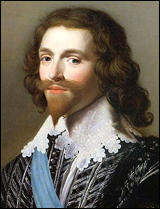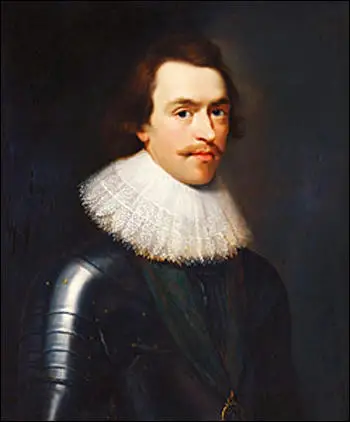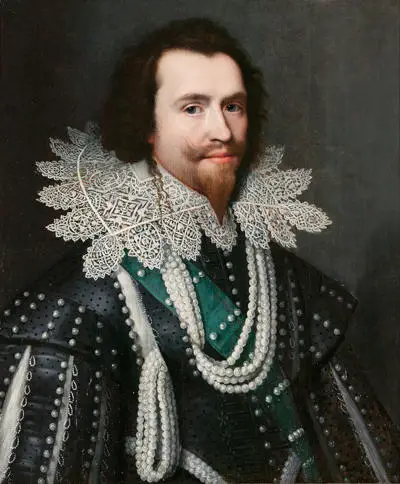George Villiers, 1st Duke of Buckingham

George Villiers, the second son of Sir George Villiers, was born in Brooksby, Leicestershire, on 28 August 1592. Villiers was not a natural scholar, "but excelled in skills such as dancing, fencing, and riding, and since these were combined with exceptional good looks and charm of manner he was well equipped for life as a courtier". (1)
In 1611 Villiers met Sir John Graham, a gentleman of the privy chamber, who acted as his mentor and promoter. He arranged for Villiers to be introduced to King James I who took an immediate liking to Villiers. Throughout his reign he associated with attractive young men and according to Maurice Ashley he had developed homosexual feelings in his youth. (2)
Although he married Anne of Denmark in 1589, and she gave birth to Henry (1594) and Charles (1600) King James spent little time with his wife and "declined to live in the same place as a woman more than he could help... and soon after his accession the queen was established at Denmark House, rarely accompanying him on his continual progresses." (3)
As Jenny Wormald has pointed out: "There is almost the danger of forgetting that, even if homosexual activity as opposed to homoerotic feeling is ascribed to the king, at the very least, James was bisexual, and succeeded, where his three predecessors had failed, in providing heirs to the throne, which after the previous half-century came as a welcome relief". (4)
One of his courtiers, Anthony Weldon, claims James had several "male lovelies" and was guilty of expressing his feelings in public: "The King's kissing them after so lascivious a mode in public, and upon the theatre, as of were, of the world, prompted many to imagine some things done in the retiring-house that exceed my expressions no less than they do my experience." (5)
George Villiers and King James
James found Villiers extremely attractive and was considered to be "beautiful as a hunting leopard". (6) Bishop Godfrey Goodman commented that Villiers was "the handsomest-bodied man in all of England; his limbs so well compacted, and his conversation so pleasing, and of so sweet a disposition." (7)
At the time he met Villiers the King was romantically involved with Robert Carr. He became the King favourite when he was 20 years-old and the following year became a groom of the bedchamber. The king, it was reported, would "pinch Carr's cheek in public, smooth his clothes, and gaze at him adoringly, even while talking to others". Over the next eight years Carr steadily accumulated the material rewards of royal infatuation and was given large estates all over England. (8)
In 1613 Carr began to make plans to marry Frances Howard, the daughter of Admiral Thomas Howard, the son of Thomas Howard, 4th Duke of Norfolk. The Howard family were having a growing influence over King James. This included Henry Howard, 1st Earl of Northampton, Thomas Howard, Earl of Arundel and Charles Howard, Lord of Effingham, They were all sympathetic to the Roman Catholic church and wanted an alliance with King Philip III of Spain. According to John Philipps Kenyon, the author of The Stuarts (1958): "They (the Howards) urged James to marry his son to the daughter of Philip III of Spain and use her huge dowry to pay off his debts, with the ultimate aim of reconciling the English church with Rome." (9)
Sir Thomas Overbury, had bitterly opposed the marriage as he was worried about the growing influence of the Howard family. He made his feelings known to James. He rejected his complaints and offered him an ambassadorship, which would have meant him living abroad. When he refused to take the post, he was arrested on 21st April, 1613, and taken to the Tower of London. Overbury threatened, in a letter written to Carr, that he would disclose information about the past life of Francis Howard. Overbury died on 15th September, 1613. Ten days later Carr married Howard. (10)
In 1614 appointed Carr as Lord Chamberlain and granted him the title, the Earl of Somerset. However, he also showed his love for Villiers by giving him the job of royal cup-bearer and in 1615 was knighted and became gentleman of the bedchamber. He was also given an annual pension of £1,000. Carr complained about his new rival. James responded by writing a letter that made it clear that he was unwilling to give up his love for Villiers. He rebuked Carr for his "strange streams of unquietness, passion, fury and insolent pride" and for "withdrawing yourself from lying in my chamber, notwithstanding my many hundred times earnestly soliciting you to the contrary". (11)
In August 1615, Villiers and James occupied the same bed at Farnham Castle, where the king was on progress. Roger Lockyer argues that this in itself does not prove the two men were having an homosexual relationship: "Sharing a bed was not uncommon in the early seventeenth century, and did not necessarily imply physical intimacy. Yet there was every indication that the relationship between the king and Villiers had entered a new phase, and that the days of Somerset's favour were numbered." (12)
The author of the The Stuarts (1958) pointed out: "At the age of twenty-two George Villiers had that rather over-ripe masculine attraction that trembles on the verge of femininity: tall and beautifully-proportioned, he had a heart-shaped face framed in dark chestnut hair and short beard, an exquisitely-curved mouth, and the dark blue eyes of the highly-sexed... His intelligence, while it existed at a low level, undoubtedly existed... Buckingham's boyish flirtatiousness enabled him to cross James with impunity." (13)
Villiers also gained the support of Sir Francis Bacon, the king's Lord Chancellor. He also feared the growing influence of the Howard family and encouraged James to order an investigation into the death of Thomas Overbury. Eventually, Robert Carr and his wife, Frances Carr, appeared in court to face the charge of murder. Frances made a full confession but Robert claimed he had nothing to do with Overbury's death. The court did not believe him and the couple were sentenced to death. James refused to allow his lover to be executed and they were both imprisoned in the Tower of London. (14)
Duke of Buckingham
Villiers was in a good position to benefit from the removal of Robert Carr from power. In January 1616 James made him master of the horse and on 27th August, he created him Viscount Villiers and gave him crown lands with the value of £30,000. He also became chief clerk for the enrolment of pleas in the court of king's bench, worth some £4000 a year. On 6th January 1617, he was elevated to the earldom of Buckingham, and in the following month he became a member of the Privy Council. The king made no secret of his feelings for his favourite. (15)
In September 1617 the King defended his friendship with Buckingham: "I am neither God nor an angel, but a man like any other. Therefore I act like a man, and confess to loving those dear to me more than other men. You may be sure that I love the Earl of Buckingham more than anyone else, and more than you who are here assembled. I wish to speak in my own behalf, and not to have it thought to be a defect, for Jesus Christ did the same, and therefore I cannot be blamed. Christ had his John, and I have my George." (16)
James was deeply in love with Buckingham who called him "Steenie" (a reference to St. Stephen whom in the Bible describes as having the "face of an angel"). According to John Philipps Kenyon, he also called him his "sweetheart", his "sweet child and wife". On one occasion, when Buckingham was on a short holiday, James wrote to him asking him to return: "My only sweet and dear child. I pray thee haste thee home to thy dad by sunsetting at the furthest... and so Lord send me comfortable and happy with thee this night." (17)
Foreign Alliances
James was sympathetic to the Roman Catholic church and came to the conclusion that his son, Charles should marry Maria Anna, the youngest daughter of King Philip III of Spain. Buckingham supported this policy but it was opposed by the English Parliament and in 1621 it called for an enforcement of recusancy laws, a naval campaign against Spain, and a Protestant marriage for the Prince of Wales. (18)
Francis Bacon, the Lord Chancellor, led the campaign against the proposed marriage and along with other MPs suggested that Charles should be married to a Protestant princess. James insisted that the House of Commons be concerned exclusively with domestic affairs and should not be involved in making decisions about foreign policy. (19)
The king's supporters responded by accusing Bacon of bribery and corruption and he was impeached before the House of Lords. Not since the fifteenth century had a great officer of the crown been overthrown in Parliament. (20) Bacon was fined £40,000 and "imprisonment at the king's pleasure". He was also barred from any office or employment in the state and forbidden to sit in parliament or come within the verge (12 miles) of the court. The fine was never collected and his imprisonment in the Tower of London lasted only three days. (21)

James refused to accept defeat and he arranged for Charles to be tutored in Spanish and the latest continental dance steps. In February 1623, Charles travelled incognito with the Duke of Buckingham, to Madrid, to meet members of the Spanish royal family. He was described as having "grown into a fine gentleman" but it was also observed that he looked undistinguished and was only five feet four inches tall. (22) During this period Charles was strongly influenced by Buckingham's political ideas. (23)
John Morrill has pointed out: "Charles's decision to undertake a personal courtship as a way of breaking through the diplomatic deadlock was an indication of his growing self-confidence. He was now commonly acting as a political agent, meeting with privy councillors, foreign ambassadors, and the duke of Buckingham, sometimes under his father's instructions, sometimes independently. The decision to travel to Spain and conduct face-to-face negotiations to conclude his marriage was a further step in his maturation." (24)
The Spanish negotiators demanded that Charles convert to Roman Catholicism as a condition of the match. They also insisted on toleration of Catholics in England and the repeal of the penal laws. After the marriage Maria Anna would have to stay in Spain until England complied with all the terms of the treaty. Charles knew that Parliament would never accept this deal and he returned to England without a bride. (25)
It was now decided to change foreign policy and James now opened up talks about the possibility of an alliance with Louis XIII of France that involved the marriage of Charles to Henrietta Maria, the king's sister. It was unprecedented for a Catholic princess to be married to a Protestant. Pope Urban VIII only gave his permission when he was assured that the treaty included "commitments about religious rights of the queen, her children, and her household; while in a separate secret document Charles promised to suspend operation of the penal laws against Catholics". (26)
In February 1624, the Duke of Buckingham, managed to persuade most members of Parliament to the new anti-Spanish policy and to negotiate a treaty with France. However, it was not explained to Parliament that the proposed marriage would involve increased toleration for Roman Catholics. (27)
These negotiations resulted in Parliament losing confidence in King James. They no longer trusted him and he was forced into making several concessions. This included a Monopoly Act, which forbade royal grants of monopolies to individuals. James also agreed to work closely with Parliament to deal with the economic crisis that the country was experiencing at the time. (28)
King Charles
James I died on 27th March 1625. Buckingham now became the new king's most important adviser. Charles married fifteen-year-old Henrietta Maria by proxy at the church door of Notre Dame on 1st May. Charles met her at Dover on 13th June and was described as being small-boned and petite and "being for her age somewhat little". (29) Another source said she was "a gawky adolescent, enormous eyes, bony wrists, projecting teeth and a minimal figure". (30) Caroline M. Hibbard provides a more positive image arguing that she had "brown hair and black eyes and a combination of sweetness and wit remarked on by almost every observer." (31)
Many members of the House of Commons were opposed to the king's marriage to a Roman Catholic, fearing that it would undermine the official establishment of the reformed Church of England. The Puritans were particularly unhappy when they heard that the king had promised that Henrietta Maria would be allowed to practise her religion freely and would have the responsibility for the upbringing of their children until they reached the age of 13. When the king was crowned on 2nd February 1626 at Westminster Abbey, his wife was not at his side as she refused to participate in a Protestant religious ceremony. (32)

At this time King Louis XIII was involved in a civil war against the Protestants (Huguenots) in France. Parliament wanted to help the Huguenots but Charles refused as he did not want to upset his wife or brother-in-law. Eventually it was agreed to send a fleet of eight ships to France. However, at the last moment Charles sent orders that the men should fight for, rather than against, Louis XIII. The captains and crews refused to accept these orders and fought against the French. (33)
Charles was willing to declare war on Spain. Rather than direct involvement in the European land war, the English Parliament preferred a relatively inexpensive naval attack on Spanish colonies in the New World, hoping for the capture of the Spanish treasure fleets and only granted a subsidy of £140,000, which was an insufficient sum for Charles's war plans. (34)
Dispute with Parliament
Charles was disappointed by this decision and so he called another Parliament. This time the Duke of Buckingham, made a long speech where "he defended his policies, assured them of his commitment to the war, including a naval assault upon Spain, and gave them details of the King's financial obligations". However, they pointed out that the country could not afford more taxes at a time of economic recession. Charles responded by dissolving Parliament. (35)
In the summer of 1627, Buckingham attempted to aid his new Huguenot allies besieged at La Rochelle in France. On 12th July, an English force of 100 ships and 6,000 soldiers arrived at Sablanceau. A French force of 1,200 infantry and 200 horsemen under the Marquis de Toiras, the island's Governor, resisted the landing from behind the dunes, but the English beachhead was maintained. The siege continued until October, during which he lost more than 4,000 of a force of 7,000 men. (36)
Sir John Eliot, Buckingham's main critic in the House of Commons, instigated impeachment proceedings against the king's main adviser. In May 1626, Charles nominated Buckingham as Chancellor of Cambridge University in a show of support, and had Eliot arrested at the door of the House. His imprisonment resulted in a great deal of protest and the the king was forced to order the release of Eliot. However, Charles refused to dismiss Buckingham and instead dissolved Parliament. (37)
Although the king continued to protect Buckingham he was hated by the public and on 23rd August 1628, he was stabbed to death at the Greyhound Pub in Portsmouth. The assassin was John Felton, an army officer who had been wounded in the earlier military adventure and believed he had been passed over for promotion by Buckingham. However, he made it clear that his act was based on his belief in the House of Commons and that by "killing the Duke he should do his country great service". (38)
Primary Sources
(1) John Philipps Kenyon, The Stuarts (1958)
At the age of twenty-two George Villiers had that rather over-ripe masculine attraction that trembles on the verge of feminity: tall and beautifully-proportioned, he had a heart-shaped face framed in dark chestnut hair and short beard, an exquisitely-curved mouth, and the dark blue eyes of the highly-sexed...
His intelligence, while it existed at a low level, undoubtedly existed... Buckingham's boyish flirtatiousness enabled him to cross James with impuunity, emerging rather with enhanced influence; his letters bubble with nonsensical charm and lovers' baby-talk, but there is a pertness even in his unvarying valediction.
(2) King James I, speech at meeting of the Privy Council (September 1617)
I, James, am neither God nor an angel, but a man like any other. Therefore I act like a man, and confess to loving those dear to me more than other men. You may be sure that I love the Earl of Buckingham more than anyone else, and more than you who are here assembled. I wish to speak in my own behalf, and not to have it thought to be a defect, for Jesus Christ did the same, and therefore I cannot be blamed. Christ had his John, and I have my George.
Student Activities
Military Tactics in the Civil War (Answer Commentary)
